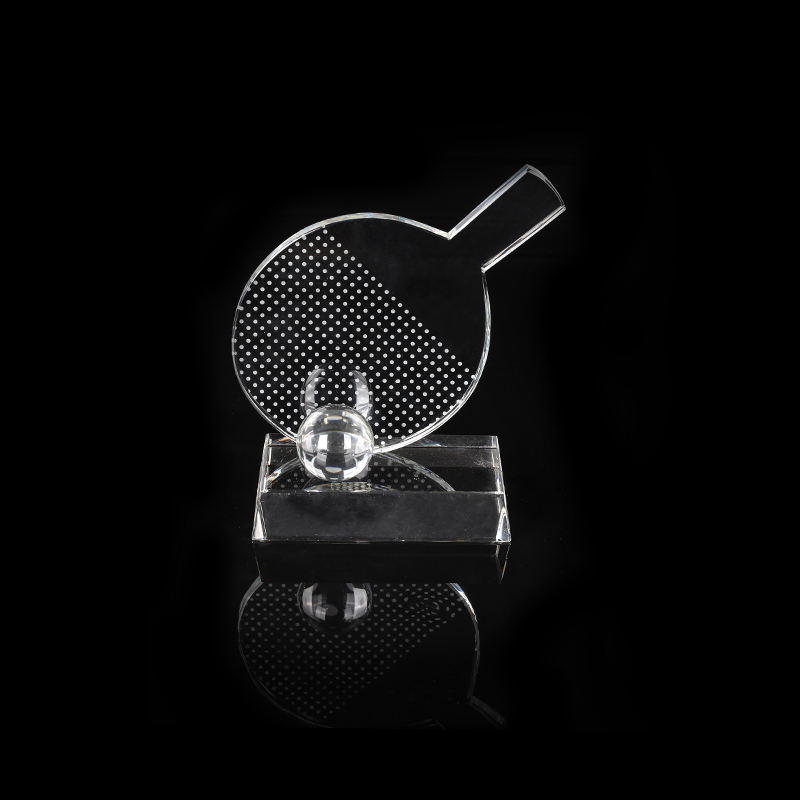Sale High Quality Crystal Etched Cubes Exporter in China
The production of crystal etched cubes, while a testament to human craftsmanship and creativity, also presents a unique set of environmental challenges. As the demand for these decorative and commemorative items grows, manufacturers must adopt sustainable practices to reduce pollution and protect the environment. This article delves into the various strategies that can be employed in the production process of crystal etched cubes to ensure an ecological footprint.

One of the primary concerns in the production of crystal etched cubes is the use of raw materials. The extraction and processing of quartz, the primary ingredient in crystal, can have significant environmental impacts. To mitigate these effects, manufacturers can source their raw materials from suppliers who adhere to responsible mining practices. This includes minimizing land disturbance, reducing water consumption, and ensuring the safe disposal of by-products.
The manufacturing process itself can also be a source of pollution. Traditional methods of etching and polishing crystal often involve the use of harsh chemicals and abrasives. To reduce the environmental impact, manufacturers can invest in eco-friendly alternatives to these substances. For instance, using water-based etching solutions instead of chemical ones can significantly reduce the release of harmful substances into the environment. Additionally, employing non-toxic polishing compounds can help reduce the contamination of air and water.
Energy consumption is another area where improvements can be made. The production of crystal etched cubes requires significant amounts of energy, particularly for heating and cooling processes. By implementing energy-efficient technologies, such as solar panels and energy recovery systems, manufacturers can reduce their reliance on fossil fuels and decrease greenhouse gas emissions. Furthermore, optimizing the production process to reduce waste and reusing heat generated during the manufacturing process can also contribute to energy savings.
Waste management is a critical aspect of sustainable production. During the production of crystal etched cubes, a considerable amount of waste is generated, including glass shards, dust, and chemical residues. Proper waste management practices, such as recycling and repurposing materials, can help reduce the amount of waste that ends up in landfills. For example, glass shards can be collected and re-melted for use in other products, while dust and residues can be treated and safely disposed of.
Water usage is another significant environmental concern in the production of crystal etched cubes. The etching and polishing processes require large volumes of water, which can contribute to water scarcity in certain regions. Manufacturers can adopt water-saving technologies, such as closed-loop systems that recycle and treat water for reuse. Additionally, implementing water-efficient cleaning methods can help reduce overall water consumption.
Transportation and logistics also play a role in the environmental impact of crystal etched cubes. The transportation of raw materials, finished products, and waste can contribute to greenhouse gas emissions and air pollution. By optimizing transportation routes and utilizing fuel-efficient vehicles, manufacturers can decrease the carbon footprint associated with the movement of goods. Moreover, collaborating with other businesses to share transportation resources can further reduce the environmental impact.
Finally, educating consumers about the importance of sustainable production and the environmental benefits of choosing eco-friendly crystal etched cubes can help drive demand for greener products. Manufacturers can provide information on their sustainable practices and the environmental benefits of their products, encouraging consumers to make more informed choices.
In conclusion, the production of crystal etched cubes, while a beautiful art form, must be approached with a commitment to environmental sustainability. By adopting responsible sourcing practices, utilizing eco-friendly materials, implementing energy-efficient technologies, managing waste effectively, conserving water, optimizing transportation, and educating consumers, manufacturers can significantly reduce the environmental impact of their operations. As the demand for crystal etched cubes continues to grow, the industry must embrace these sustainable practices to ensure a cleaner, greener future for all.

 English
English 中文简体
中文简体 عربى
عربى









